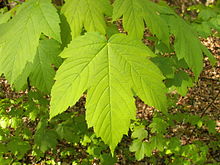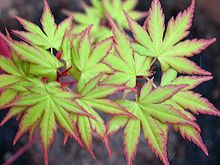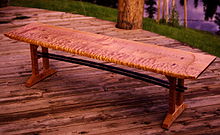- Maple
-
For other uses, see Maple (disambiguation).
Acer 
Acer pseudoplatanus (Sycamore maple) foliage Scientific classification Kingdom: Plantae (unranked): Angiosperms (unranked): Eudicots (unranked): Rosids Order: Sapindales Family: Sapindaceae[1], or Aceraceae Subfamily: Hippocastanoideae Genus: Acer
L.Species 
Distribution Acer (pronounced /ˈeɪsər/)[2] is a genus of trees or shrubs commonly known as maple.
Maples are variously classified in a family of their own, the Aceraceae, or together with the Hippocastanaceae included in the family Sapindaceae. Modern classifications, including the Angiosperm Phylogeny Group system, favour inclusion in Sapindaceae. The type species of the genus is Acer pseudoplatanus (Sycamore maple).[3]
There are approximately 129 species, most of which are native to Asia,[4] with a number also appearing in Europe, northern Africa, and North America. Only one species, the poorly studied Acer laurinum, is native to the Southern Hemisphere.[5] Fifty four species of maples meet the International Union for Conservation of Nature criteria for being under threat of extinction in their native habitat.[6]
The word Acer derives from a Latin word meaning "sharp" (compare "acerbic"), referring to the characteristic points on maple leaves. It was first applied to the genus by the French botanist Joseph Pitton de Tournefort in 1700. The earliest known fossil maple is Acer alaskense, from the Latest Paleocene of Alaska.
Contents
Morphology
 Acer saccharum (Sugar maple)
Acer saccharum (Sugar maple)
Most maples are trees growing to 10 – 45 meters (30 – 145 ft) in height. Others are shrubs less than 10 metres tall with a number of small trunks originating at ground level. Most species are deciduous, but a few in southern Asia and the Mediterranean region are evergreen. Most are shade-tolerant when young and are often late-successional in ecology; many of the root systems are typically dense and fibrous. A few species, notably Acer cappadocicum, frequently produce root sprouts, which can develop into clonal colonies.[3]
 Acer circinatum (Vine maple) leaves showing the palmate veining typical of most species
Acer circinatum (Vine maple) leaves showing the palmate veining typical of most species
Maples are distinguished by opposite leaf arrangement. The leaves in most species are palmate veined and lobed, with 3 to 9 (rarely to 13) veins each leading to a lobe, one of which is central or apical. A small number of species differ in having palmate compound, pinnate compound, pinnate veined or unlobed leaves. Several species, including Acer griseum (Paperbark maple); Acer mandshuricum (Manchurian maple); Acer maximowiczianum (Nikko maple); and Acer triflorum (Three-flowered maple), have trifoliate leaves. One species, Acer negundo (Box-elder), has pinnately compound leaves that may be simply trifoliate or may have five, seven, or rarely nine leaflets. A few, such as Acer laevigatum (Nepal maple) and Acer carpinifolium (Hornbeam maple), have pinnately veined simple leaves.
Acer rubrum (Red maple) flowers
The flowers are regular, pentamerous, and borne in racemes, corymbs, or umbels. They have four or five sepals, four or five petals about 1 – 6 mm long (absent in some species), four to ten stamens about 6 – 10 mm long, and two pistils or a pistil with two styles. The ovary is superior and has two carpels, whose wings elongate the flowers, making it easy to tell which flowers are female. Maples flower in late winter or early spring, in most species with or just after the appearance of the leaves, but in some before the trees leaf out.[7]
Maple flowers are green, yellow, orange or red. Though individually small, the effect of an entire tree in flower can be striking in several species. Some maples are an early spring source of pollen and nectar for bees.The distinctive fruit are called samaras or "maple keys". These seeds, or 'whirlybirds,' occur in distinctive pairs each containing one seed enclosed in a "nutlet" attached to a flattened wing of fibrous, papery tissue. They are shaped to spin as they fall and to carry the seeds a considerable distance on the wind. Children often call them "helicopters" due to the way that they spin as they fall. Seed maturation is usually in a few weeks to six months after flowering, with seed dispersal shortly after maturity. However, one tree can release hundreds of thousands of seeds at a time. Depending on the species, the seeds can be small and green to orange and big with thicker seed pods. The green seeds are released in pairs, sometimes with the stems still connected. The yellow seeds are released individually and almost always without the stems. Most species require stratification in order to germinate, and some seeds can remain dormant in the soil for several years before germinating.[3]
The genus is subdivided by its morphology into a multitude of sections and subsections.[8]
Pests and diseases
The leaves are used as a food plant for the larvae of a number of Lepidoptera species (see List of Lepidoptera that feed on maples). Aphids are also very common sap-feeders on maples. In horticultural applications a dimethoate spray will solve this.
In the United States and Canada, all maple species are threatened by the Asian Longhorned Beetle (Anoplophora glabripennis). Infestations have resulted in the destruction of thousands of maples and other tree species in Illinois, Massachusetts, New Jersey and New York.[9]
Maples are affected by a number of fungal diseases. Several are susceptible to Verticillium wilt caused by Verticillium species, which can cause significant local mortality. Sooty bark disease, caused by Cryptostroma species, can kill trees which are under stress due to drought. Death of maples can rarely be caused by Phytophthora root rot and Ganoderma root decay. Maple leaves in late summer and autumn are commonly disfigured by "tar spot" caused by Rhytisma species and mildew caused by Uncinula species, though these diseases do not usually have an adverse effect on the trees' long-term health.[10]
Uses
Horticulture
 A red maple tree between pine trees.
A red maple tree between pine trees.
 Acer palmatum (Japanese maple) has over 1,000 cultivars. This cultivar is A. palmatum 'Sango kaku', sometimes called "coralbark maple".
Acer palmatum (Japanese maple) has over 1,000 cultivars. This cultivar is A. palmatum 'Sango kaku', sometimes called "coralbark maple".
Maples are planted as ornamental trees by homeowners, businesses and municipalities. Acer platanoides (Norway maple) is especially popular as it is fast-growing and extremely cold-resistant, though it is also an invasive species in some regions. Other maples, especially smaller or more unusual species, are popular as specimen trees.[3]
Cultivars
Numerous maple cultivars which have been selected for particular characteristics can be propagated only by asexual reproduction such as cuttings, tissue culture, budding or grafting. Acer palmatum (Japanese maple) alone has over 1,000 cultivars, most selected in Japan, and many of them no longer propagated or not in cultivation in the Western world. Some delicate cultivars are usually grown in pots and rarely reach heights of more than 50–100 cm.
Bonsai
 Bonsai "Roter Fächerahorn"
Bonsai "Roter Fächerahorn"
Maples are a popular choice for the art of bonsai. Acer palmatum (Japanese maple), Acer buergerianum (Trident maple), Acer ginnala (Amur maple), Acer campestre (Field maple) and Montpellier maple (A. monspessulanum) are popular choices and respond well to techniques that encourage leaf reduction and ramification, but most species can be used.[3] [11]
Collections
 Acer griseum is widely grown for its decorative bark
Acer griseum is widely grown for its decorative bark
Maple collections, sometimes called aceretums, occupy space in many gardens and arboreta around the world including the "five great W's" in England: Wakehurst Place Garden, Westonbirt Arboretum, Windsor Great Park, Winkworth Arboretum and Wisley Garden. In the United States, the aceretum at the Harvard-owned Arnold Arboretum in Boston is especially notable. In the number of species and cultivars, the Esveld Aceretum in Boskoop, Netherlands is the largest in the world.[3]
Tourism
Many maples have bright autumn foliage, and many countries have leaf-watching traditions. In Japan, the custom of viewing the changing colour of maples in the autumn is called "momijigari". Nikko and Kyoto are particularly favoured destinations for this activity. In addition, in Korea, the same viewing activity is called "Danpung-Nori" and the Seoraksan and Naejang-san mountains are very famous places for it.
The Acer saccharum (sugar maple) are a contributor to seasonal Fall tourism in North America, particularly in Central Ontario, Québec, Vermont, New Hampshire and Western Massachusetts.
Commercial uses
Maples are important as source of syrup and wood. Dried wood is often used for the smoking of food. They are also cultivated as ornamental plants and have benefits for tourism and agriculture.
Maple syrup
Further information: Maple syrupThe Sugar maple (Acer saccharum) is tapped for sap, which is then boiled to produce maple syrup or made into maple sugar or maple taffy. It takes about 40 litres of Sugar maple sap to make a litre of syrup. Syrup can be made from closely related species as well, but their output is inferior.
Timber
Some of the larger maple species have valuable timber, particularly Sugar maple in North America, and Sycamore maple in Europe. Sugar maple wood — often known as "hard maple" — is the wood of choice for bowling pins, bowling alley lanes, pool cue shafts, and butcher's blocks. Maple wood is also used for the manufacture of wooden baseball bats, though less often than ash or hickory due to the tendency of maple bats to shatter when broken. The maple bat was introduced to Major League Baseball (MLB) in 1998 by Sam Holman of Sam Bats. Today it is the standard maple bat most in use by professional baseball.[12] Maple is also commonly used in archery as the core material in the limbs of a Recurve Bow due to its stiffness and strength.
Maple wood is often graded based on physical and aesthetic characteristics. The most common terminology includes the grading scale from common #2 which is unselected, and often used for craft woods, common #1 used for commercial and residential buildings, Clear, and select grade which sought out for fine woodworking.[13]
Some maple wood has a highly decorative wood grain, known as flame maple, quilt maple, birdseye maple and burl wood. This condition occurs randomly in individual trees of several species, and often cannot be detected until the wood has been sawn, though it is sometimes visible in the standing tree as a rippled pattern in the bark.
These select decorative wood pieces also have subcategories which further filter the aesthetic looks. Crotch Wood, Bees Wing, Cats Paw, Old Growth and Mottled are some terms used to describe the look of these decorative woods.[14]
Maples have a long history of use for furniture production in United States.[15]
Tonewood
Maple is considered a tonewood, or a wood that carries sound waves well, and is used in numerous musical instruments. Maple is harder and has a brighter sound than Mahogany, which is the other major tonewood used in instrument manufacture.[citation needed]
The back, sides, and neck of most violins, violas, cellos, double basses and many guitars are made from maple.
Electric guitar necks are commonly made from maple. The necks of the Fender Stratocaster and Telecaster were originally an entirely maple one piece neck, but later were also available with rosewood fingerboards. Maple fingerboards have a brighter sound than rosewood. The tops of Gibson's Les Paul guitars are made from carved maple. Many Les Pauls have quilted or flamed maple tops, and these models are particularly prized by players and collectors. Very few solid body guitars are made entirely from maple, as it is considered too heavy. Many guitars do, however, have maple tops or veneers. Gibson uses laminated maple in the manufacture of many of its semi-hollowbody guitars.
Maple is also often used to make bassoons and sometimes for other woodwind instruments.
Many drums are made from maple. From the 70s to the 90s, maple drum kits were a vast majority of all drum kits made, but in recent years, Birch has become popular for drums once again. Some of the best drum-building companies use maple extensively throughout their mid-pro range.[3] Maple drums are favored for their bright resonant sound.[16]
Agriculture
As they are a major source of pollen in early spring before many other plants have flowered, maples are important to the survival of honeybees that play a commercially important role later in the spring and summer.
Pulpwood
Maple is used as pulpwood. The fibers have relatively thick walls that prevents collapsing upon drying. This gives good bulk and opacity in paper. Maple also gives paper with good printing properties.
Gallery
-
Acer cappadocicum (Cappadocian maple)
-
Acer carpinifolium leaves
-
Acer freemanii 'Autumn Blaze' (a cross between Acer rubrum and Acer saccharinum
-
Acer macrophyllum flowers and young leaves
-
Acer laevigatum leaves and fruit
-
Acer sempervirens foliage
-
Acer ginnala foliage
-
Acer palmatum trees and bamboo in Japan
-
Acer grandidentatum (Bigtooth Maple) in autumn colour
-
Acer platanoides leaf
-
Acer palmatum leaf in autumn
-
thumb|right|Acer platanoides (Norway maple) samaras
For more information go on awesome101.com,with lots of juicy info.
References
- ^ Stevens, P. F. (2001 onwards). Angiosperm Phylogeny Website. Version 9, June 2008 [and more or less continuously updated since]. http://www.mobot.org/MOBOT/research/APweb/.
- ^ Sunset Western Garden Book, 1995:606–607
- ^ a b c d e f g van Gelderen, C. J. & van Gelderen, D. M. (1999). Maples for Gardens: A Color Encyclopedia
- ^ http://www.efloras.org/florataxon.aspx?flora_id=2&taxon_id=100167
- ^ Gibbs, D. & Chen, Y. (2009) The Red List of Maples Botanic Gardens Conservation International (BGCI) ISBN: 978-1-905164-31-8
- ^ Gibbs, D. & Chen, Y. (2009) The Red List of Maples Botanic Gardens Conservation International (BGCI) ISBN: 978-1-905164-31-8
- ^ Huxley, A., ed. (1992). New RHS Dictionary of Gardening. Macmillan ISBN 0-333-47494-5.
- ^ Classification of maples
- ^ http://www.beetlebusters.info/; http://www.umassgreeninfo.org/fact_sheets/wood_attackers/asian_longhorned_beetle_MA.html#226
- ^ Phillips, D. H. & Burdekin, D. A. (1992). Diseases of Forest and Ornamental Trees. Macmillan. ISBN 0-333-49493-8.
- ^ D'Cruz, Mark. "Ma-Ke Bonsai Care Guide for Acer buergerianum". Ma-Ke Bonsai. http://makebonsai.com/guide/bonsailink.asp?quicklink=5030&name=Acer_buergerianum. Retrieved 2011-7-5.
- ^ Sam Holman Maple Baseball Bats
- ^ The Illustrated Grading Guide to American Hardwoods
- ^ Wood Terms and Examples
- ^ Joseph Aronson (1965). The encyclopedia of furniture. Random House, Inc.. pp. 300–. ISBN 9780517037355. http://books.google.com/books?id=j3XWBk-qMV0C&pg=PT300. Retrieved 8 September 2010.
- ^ Geoff Nicholls; Tony Bacon (1 June 1997). The drum book. Hal Leonard Corporation. pp. 54–. ISBN 9780879304768. http://books.google.com/books?id=rWq1_qnZ0mAC&pg=PT54. Retrieved 19 October 2010.
Bibliography
Philips, Roger (1979). Trees of North America and Europe. New York: Random House, Inc.. ISBN 0-394-50259-0.
Categories: -
Wikimedia Foundation. 2010.















